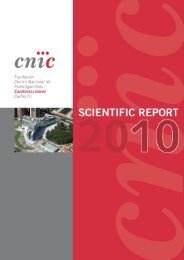Appendix - CNIC
Appendix - CNIC
Appendix - CNIC
You also want an ePaper? Increase the reach of your titles
YUMPU automatically turns print PDFs into web optimized ePapers that Google loves.
SCIENTIFIC REPORT ´09 1 Cardiovascular Developmental Biology<br />
Molecular regulation of heart<br />
development and disease<br />
> RESEARCH INTEREST<br />
Head of Laboratory: Enrique Lara-Pezzi<br />
Technician: Marina Mercedes López Oñaleta<br />
Our lab studies the molecular mechanisms that regulate<br />
cardiac development and heart disease. One of our main<br />
interests is the role of alternative splicing (AS) in these<br />
processes. AS is the molecular process that removes introns<br />
from immature pre-mRNAs and links exons together in<br />
different combinations. This mechanism affects 86% of all<br />
human genes and is in part responsible for the great diversity<br />
of proteins that are generated from the relatively small<br />
number of genes found in the human genome.<br />
Together with the Genomics Unit at the <strong>CNIC</strong>, we are using<br />
high density exon microarrays and deep sequencing to create<br />
a global map of AS isoforms expressed during heart failure.<br />
We are also studying cis-regulatory sequences and transregulatory<br />
splicing factors associated with AS and analyzing<br />
their role in the heart by using knockdown and knockout<br />
strategies.<br />
A good example of how alternative splicing can dramatically<br />
change protein function is the calcineurin variant CnAβ1.<br />
Calcineurin regulates a wide variety of physiological and<br />
pathological processes, including cardiac development and<br />
hypertrophy. CnAβ1 is a naturally occurring splice variant of<br />
the calcineurin A gene which contains a unique C-terminal<br />
region, different from the autoinhibitory domain present in<br />
other CnA isoforms. We recently showed that CnAβ1 regulates<br />
cell proliferation and enhances skeletal muscle regeneration.<br />
Our results further suggest that CnAβ1 protects the heart from<br />
the effects of myocardial infarction by improving cardiac<br />
function and reducing inflammation and scar formation.<br />
Diversity of calcineurin A isoforms. A, The calcium-regulated phosphatase calcineurin (Cn) consists of two subunits: a catalytic subunit (CnA)<br />
and a regulatory subunit (CnB). There are three distinct CnA isoforms, encoded by three genes (CnAα, CnAβ and CnAγ). Two variants of CnAβ,<br />
the main CnA isoform expressed in the heart, are generated by alternative splicing (CnAβ1 and CnAβ2). B, Like other CnA isoforms, CnAβ2<br />
includes a C-terminal autoinhibitory domain that keeps the enzyme inactive in the absence of calcium. Uniquely, CnAβ1 has a C-terminal<br />
domain with no similarity to any known protein, as a result of the insertion of intron 12-13 before exon 13.<br />
16



